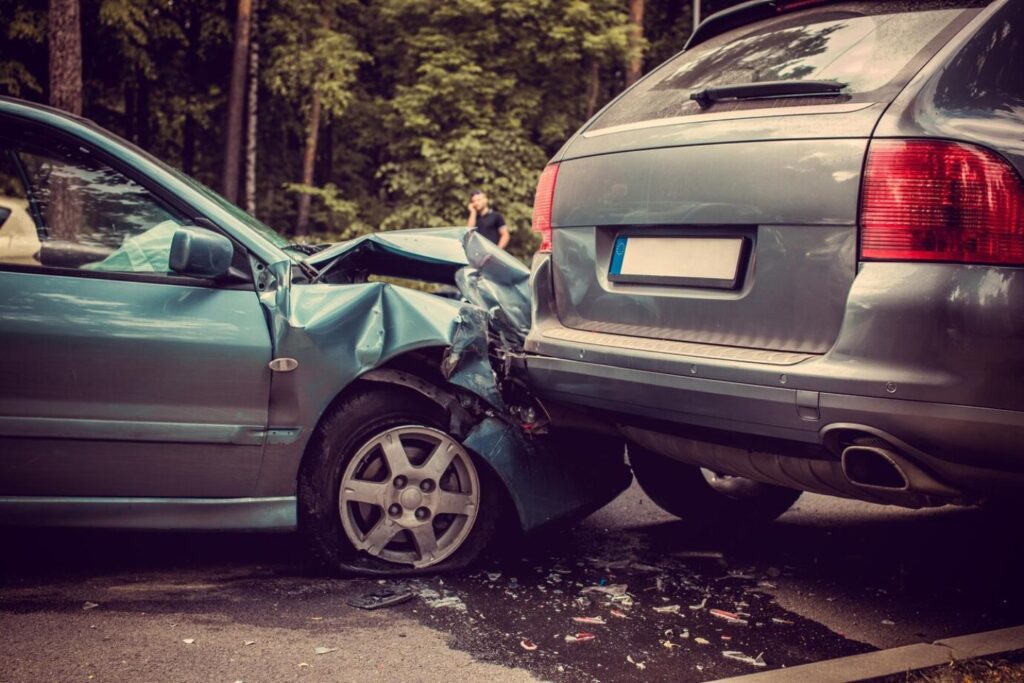Accidents in Palm Springs are more than just headlines; they represent a significant risk to everyone on the road. With a fatality rate of 35.45 per 100,000 people from 2016 to 2020, Palm Springs ranks alarmingly high among small cities for roadway deaths. This statistic underscores a critical concern for safety and the aftermath families and victims face.
In this article, we delve into the primary causes of Palm Springs crashes and the legal avenues available for those affected. Our goal is to simplify the complexities of personal injury law, providing readers with the crucial knowledge needed to navigate their legal rights and secure the compensation they rightfully deserve.
Common Causes of Accidents in Palm Springs
Based on the Office of Traffic Safety (OTS) rankings report 2021, Palm Springs has witnessed significant roadway challenges.
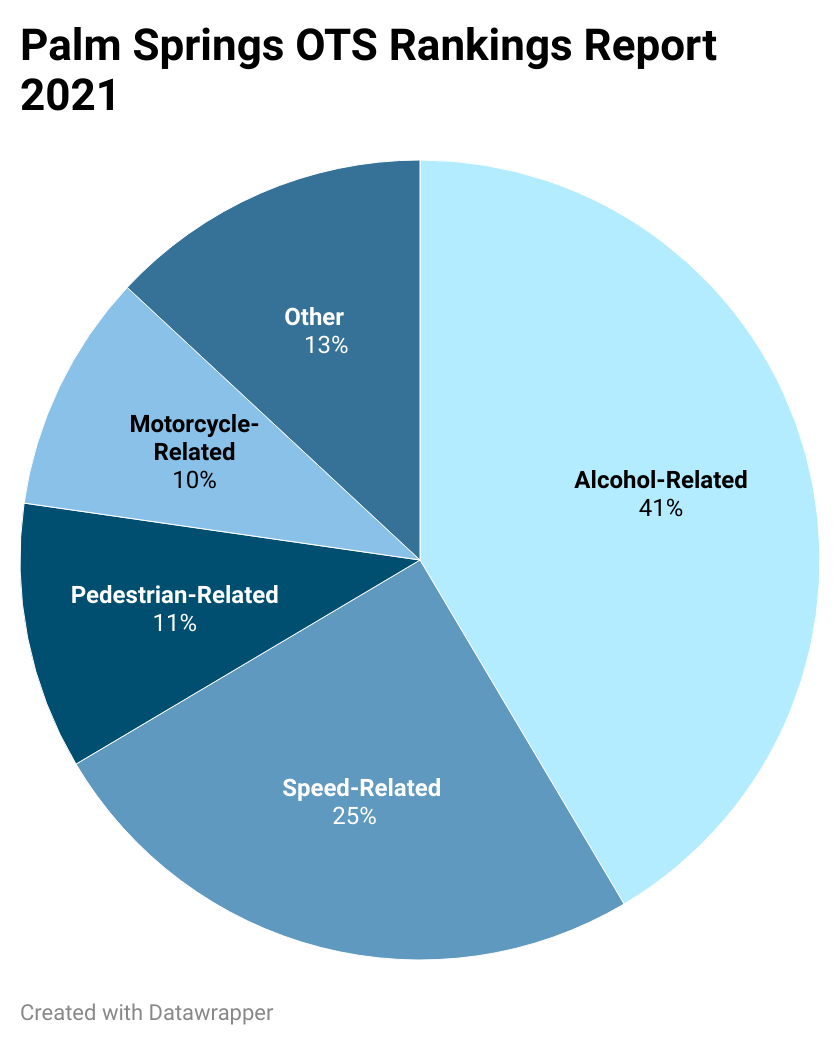

Here are the key factors that can lead to potential accidents in Palm Springs:
Substance Use
Alcohol plays a significant role in road accidents in Palm Springs. Out of 344 total fatalities and injuries recorded, 73 involved alcohol. It’s especially concerning that younger drivers, those aged 21-34, are largely involved, making Palm Springs the second out of 93 cities for alcohol-related incidents in this age group.
Speed and Nighttime Driving
Speeding stands out as a critical safety issue, with Palm Springs experiencing 44 speed-related crashes. Nighttime driving increases the risk, with an equal number of accidents occurring between 9:00 pm and 2:59 am, underscoring the dangers of high speeds under the cloak of darkness.
Vulnerable Road Users
The data highlights a significant risk for motorcyclists, pedestrians, and bicyclists. With 17 motorcycle-related injuries and fatalities, motorcyclists’ vulnerability is evident. Pedestrians face significant risks as well, with 19 incidents, particularly those over 65, where Palm Springs ranks alarmingly high at fourth out of 93.
Hit and Run
Hit-and-run incidents form a disturbing chapter in Palm Springs’ traffic safety narrative, with 13 such crashes reported. This troubling behavior not only violates legal and moral standards but also leaves victims in a precarious position when seeking support and compensation.
If you’ve been affected by a road accident in Palm Springs, The Personal Injury Center is here for you. We can be your ally in navigating the legal process, ensuring you receive the support and compensation you deserve.
What to Do Immediately After a Palm Springs Crash?
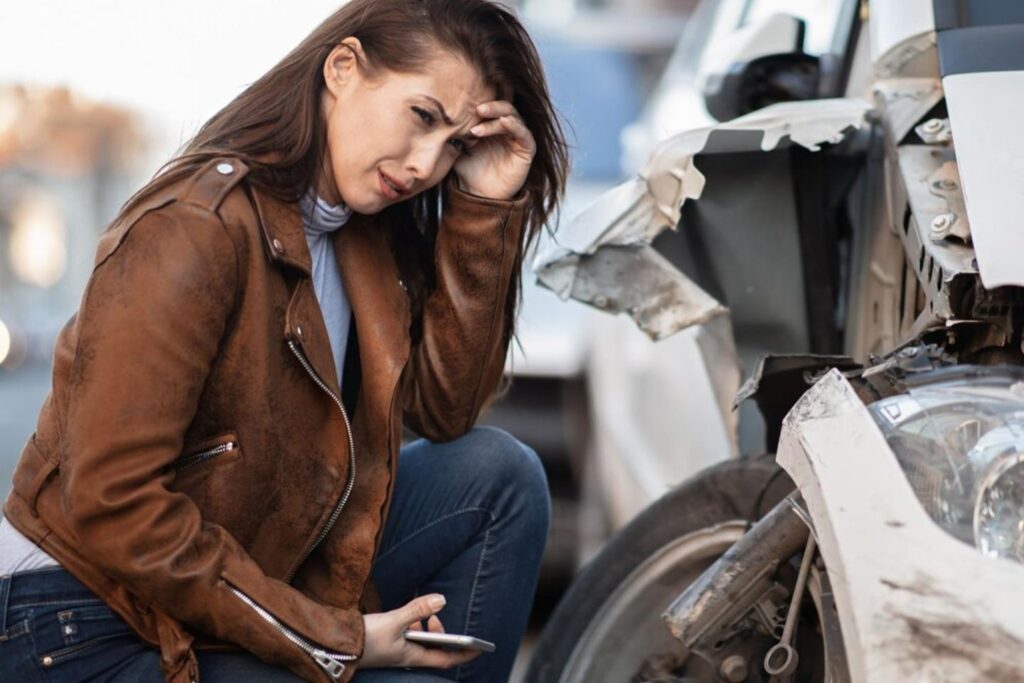

In the confusing moments after a vehicle collision, taking the right steps can have a profound impact on your safety and legal rights. Here’s a quick guide to protect both:
- Ensure Safety: First and foremost, prioritize the safety of all passengers. If it’s safe, move to a secure location to prevent further accidents. This proactive step can also safeguard you from secondary collisions in busy traffic.
- Check for Injuries: Conduct a quick but thorough assessment for any injuries among yourself and others involved. Immediate medical attention can be vital, so don’t hesitate to call emergency services for help. Early treatment is key to recovery and documenting accident-related injuries.
- Call the Police: A police report is a fundamental piece of evidence. The police will officially document the accident scene, providing an unbiased account of events which is crucial for any future legal or insurance claims.
- Exchange Information: Swap contact, vehicle, and insurance details with other drivers involved, ensuring you have the necessary information for a claim. However, steer clear of discussing the fault or details of the accident to avoid any statements that could be misconstrued later.
- Document the Scene: Capture comprehensive photographs of the accident scene, including all vehicles involved, any visible damages, road conditions, traffic signs, and injuries. Visual evidence adds a powerful layer of documentation to support your claim.
- Gather Witness Details: Witnesses can offer crucial perspectives on the crash that may support your account of events. Secure names and contact information from anyone who saw the accident, as their statements could be invaluable during insurance claims or legal proceedings.
- Notify Your Insurance: Promptly informing your insurance company about the crash sets the claims process in motion. Yet, it’s wise to speak with a legal advisor before providing detailed statements or accepting any settlements, to ensure your rights are fully protected.
- Track Your Expenses: Compile a detailed record of all accident-related expenses, including medical bills, vehicle repairs, and any lost wages due to injury. This comprehensive financial documentation will be essential for accurately claiming compensation.
- Follow-Up on Medical Care: Adhering to recommended medical treatments and follow-up appointments is crucial for your health and for substantiating your claim with ongoing medical evidence.
Navigating the Legal Process Following a Palm Springs Crash
When you’re involved in a Palm Springs crash, understanding the legal maze can be daunting. It’s not just about knowing what to do but the why and how behind each step.
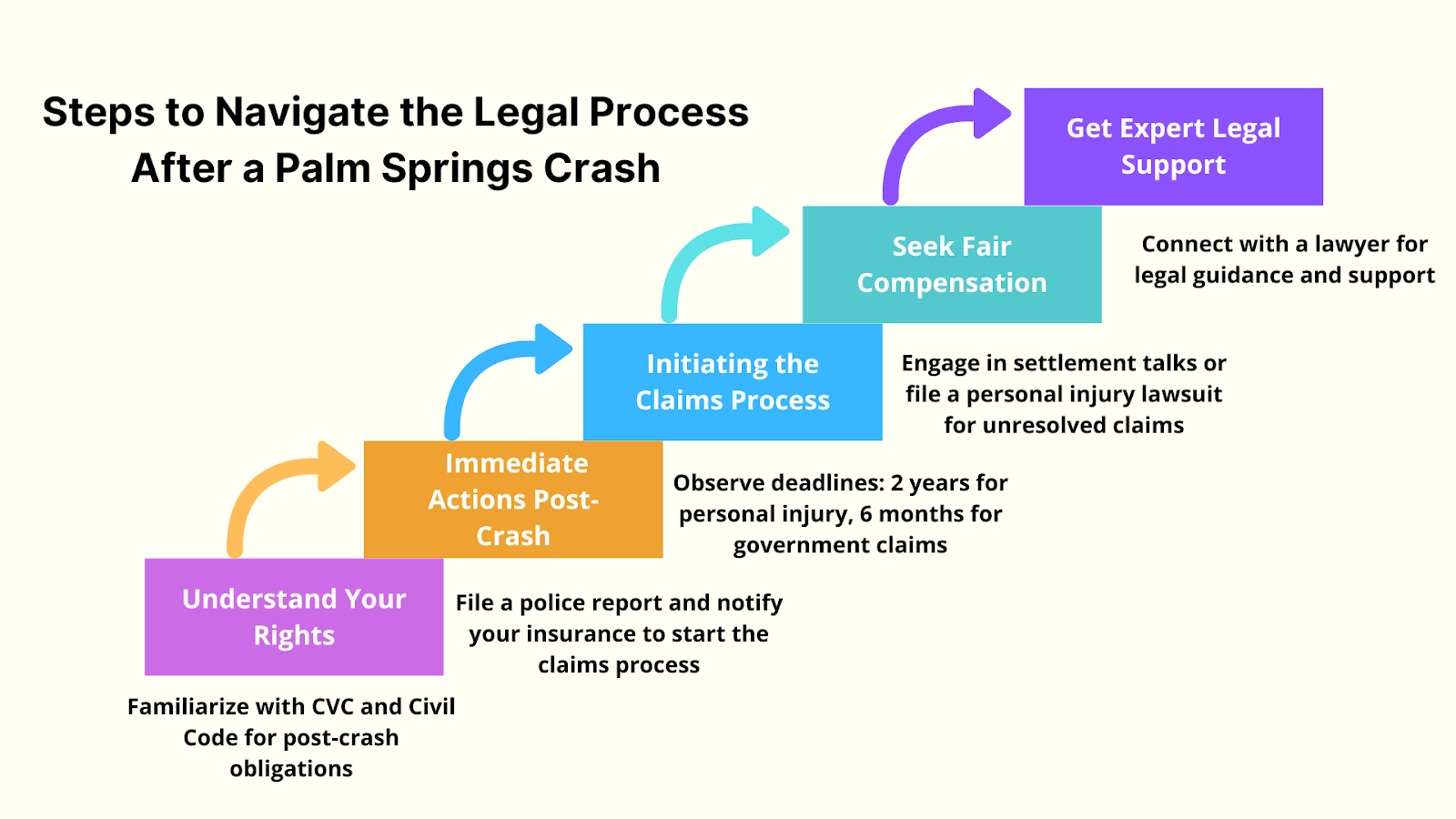

Here’s a quick breakdown of the laws and legal procedures:
Understanding Your Rights Under State Law
- California Vehicle Code (CVC): After a crash, you’re legally required to share your contact and insurance details with the other parties involved (CVC §16025). If someone is hurt, you’re also obligated to help as much as you safely can (CVC §20003). These steps are crucial in determining who is responsible for the crash and how damages might be covered.
- California Civil Code: If you’re hurt or your property is damaged, you might be entitled to reimbursement for your losses (Civil Code §3281). In extreme cases where someone’s actions were especially harmful, you might be eligible for additional compensation as punitive damages (punishment to the wrongdoer) (Civil Code §3294). This part of the law aims to make sure you’re not left footing the bill for someone else’s negligence or ignorance.
Filing a Police Report and Insurance Notification
- California Highway Patrol Policy: When the police arrive at the scene, they’ll put together a Traffic Collision Report (CHP 555). This report is an official record that includes what happened, who was involved, and any immediate apparent reasons for the crash. It’s a key piece of evidence for insurance claims and any legal action.
- Insurance Notification: California laws require you to let your insurance company know about the crash promptly. Doing this starts the claim process and ensures your insurer can’t deny you coverage for waiting too long.
Initiating the Claims Process
- Statute of Limitations: If you want to take legal action, you must follow the legal timeframe for lawsuits. In California, you have two years from the date of the accident to file a lawsuit for injuries (CCP §335.1). Missing this deadline could lose your right to claim.
- Government Claims: If your crash involved a government vehicle or happened on government property, you have only six months to file a claim (California Government Code §911.2). It’s a shorter window because government entities need to manage their budgets and liabilities differently.
Legal Representation and Lawsuit Filings
- Settlement and Negotiation: Before moving to court, the first step is often to try and reach a settlement directly with the insurance company or the at-fault party. This phase involves presenting your claim, backed by evidence of the accident and your injuries, and negotiating a fair compensation amount without the need for formal legal proceedings.
- Personal Injury Lawsuit Process: Initiating a personal injury lawsuit is a critical step when negotiations don’t lead to a satisfactory settlement. This formal legal action starts with drafting and filing a complaint (CCP §410.30) against those responsible for the crash, detailing the accident, the injuries sustained, and the compensation you’re seeking.
The legal processes, coupled with the stress of injuries, can be confusing. However, you’re not alone in this journey. The Personal Injury Center offers support and guidance, connecting you with skilled lawyers who are committed to defending your rights and assisting you in obtaining the compensation you deserve.
Common Challenges in Crash Accident Claims
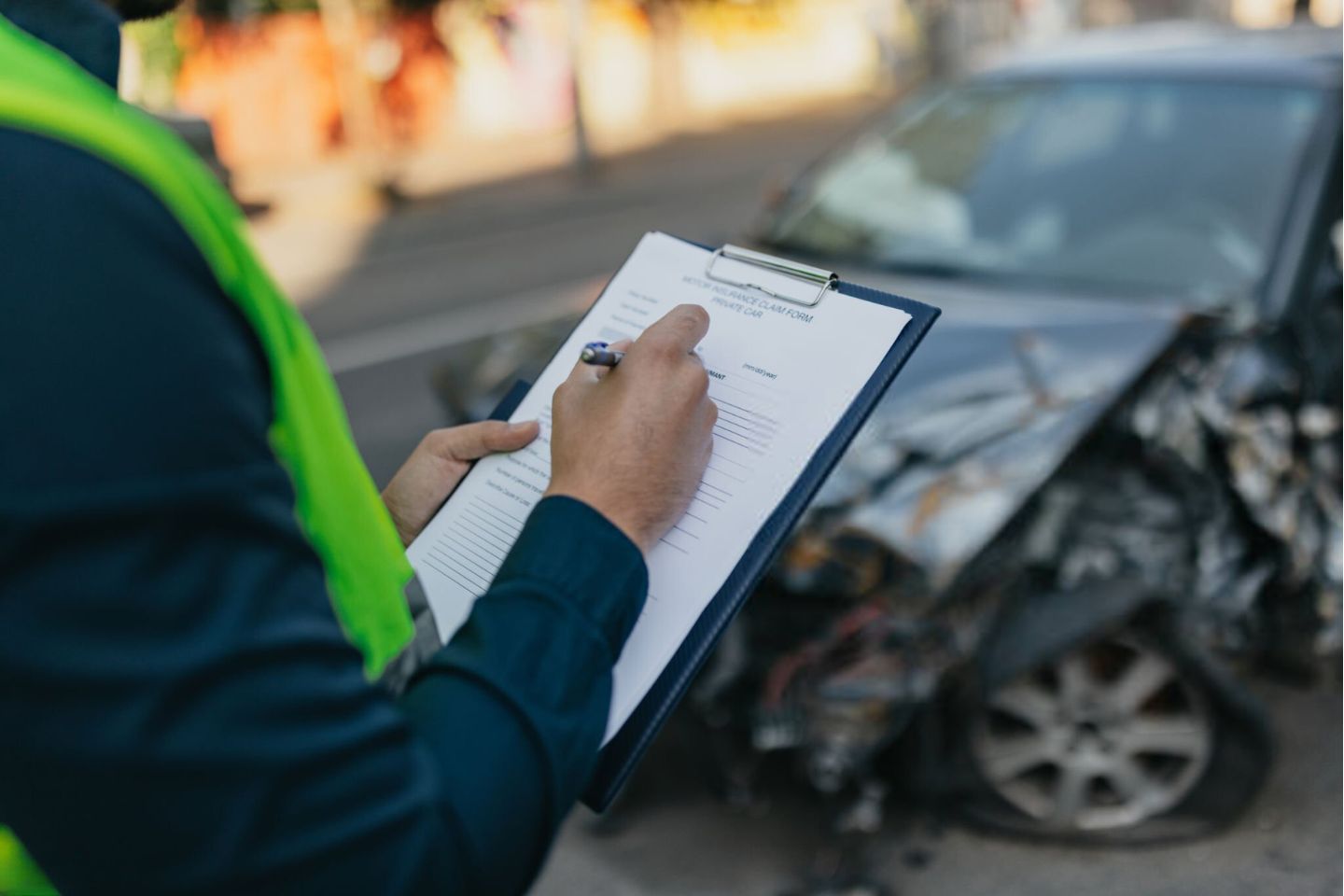

Navigating the aftermath of a crash in Palm Springs presents a series of hurdles, each complicating the path to fair compensation.
Determining Fault and Liability
In California’s comparative fault system, outlined in Civil Code §1714, establishing the degree of fault can become contentious. This system allows for the apportionment of blame among all parties involved, potentially reducing the compensation due to the plaintiff (victim). The intricacies of proving liability can significantly delay or decrease the settlement amounts, making it essential to gather comprehensive evidence to support your claim.
Dealing with Insurance Companies
Insurance companies, governed by California Insurance Code §790.03, may engage in practices perceived as acting in bad faith, such as unduly delaying claim processing or denying claims without a reasonable basis.
Claimants often find themselves battling for their rights against well-resourced insurers, making it a scenario that requires persistence and, often, legal intervention to navigate successfully.
Accurate Calculation of Damages
Quantifying the full extent of damages involves distinguishing between economic and non-economic damages, the latter including pain and suffering as per Civil Code §1431.2. The challenge lies in attaching a monetary value to intangible losses, which requires a strong understanding of the law and often, persuasive argumentation in negotiations or court.
Uninsured or Underinsured Motorists
When accidents involve uninsured or underinsured drivers, despite the mandates of Insurance Code §11580.2, securing adequate compensation becomes more complex. This situation may leave claimants exploring alternative compensation methods, such as filing a claim under their uninsured motorist coverage, a process filled with its own set of challenges.
Proving Personal Injury Damages
The burden of proof lies with the claimant to demonstrate the extent of their injuries and directly link them to the crash. This often requires a detailed compilation of medical records, expert testimony, and a clear narrative that connects the dots between the accident and the subsequent harm suffered.
Each of these challenges highlights the need for knowledgeable legal guidance to effectively navigate the claim process. The Personal Injury Center serves as a vital resource, providing access to experienced legal professionals who specialize in tackling these hurdles directly, ensuring that victims of Palm Springs crashes are fully prepared to seek the justice and compensation they deserve.
Key Takeaways
|



